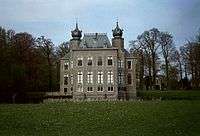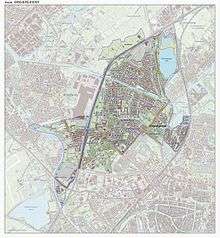Oegstgeest
| Oegstgeest | |||
|---|---|---|---|
| Town / Municipality | |||
|
Wind mill Oudenhofmolen in Oegstgeest | |||
| |||
.svg.png) Location in South Holland | |||
| Coordinates: 52°11′N 4°28′E / 52.183°N 4.467°ECoordinates: 52°11′N 4°28′E / 52.183°N 4.467°E | |||
| Country | Netherlands | ||
| Province | South Holland | ||
| Government[1] | |||
| • Body | Municipal council | ||
| • Mayor | Jan Waaijer (CDA) | ||
| Area[2] | |||
| • Total | 7.97 km2 (3.08 sq mi) | ||
| • Land | 7.30 km2 (2.82 sq mi) | ||
| • Water | 0.67 km2 (0.26 sq mi) | ||
| Elevation[3] | 0 m (0 ft) | ||
| Population (May 2014)[4] | |||
| • Total | 22,903 | ||
| • Density | 3,137/km2 (8,120/sq mi) | ||
| Demonym(s) | Oegstgeestenaar | ||
| Time zone | CET (UTC+1) | ||
| • Summer (DST) | CEST (UTC+2) | ||
| Postcode | 2340–2343 | ||
| Area code | 071 | ||
| Website |
www | ||
Oegstgeest (Dutch pronunciation: [ˌuxstˈxeːst]) is a town and municipality in the province of South Holland in the western Netherlands. Its population was 22,903 in 2014.
Etymology
The portion geest in the name refers to the geest lands, which were excavated in the seventeenth century for the benefit of the urban expansion of Leiden.
About the Oegst part more uncertainty exists. Different stories go about. The name was formerly often spelled Oestgeest or Oostgeest, which could indicate the geographical location of the village: east of the geest lands. However, the oldest spelling found in a copy of a list of goods of the St. Martin's Cathedral in Utrecht from the tenth century states Osgeresgeest. This could indicate an original resident and owner of the territory: Osger.
In the Middle Ages they also spoke of the Church of Kerckwerve if one referred to the Oegstgeester parish church (now the Green Church).
History
Oegstgeest is one of the earliest inhabited places along the coast. Evidence of a Batavian settlement from the second century was found in 1946 in an extension of a coastal dune in the Elgeesterpolder, although it is not certain whether this location remained permanently inhabited in the centuries after that.
By the 9th century there was already a little church in the same location as the current Little Green Church (Groen Kerkje) which, according to legend, was dedicated by Willibrord. The existence of this church is an indication that there may have been a community there.
From the 11th to the 14th century, Oegstgeest enjoyed a period of progress. This ended when Leiden was granted city rights. The carrying out of trades and construction were no longer permitted within a certain distance from the city. In 1399, the heerlijkheid of Oegstgeest and that of Poelgeest were merged because their declining populations could no longer afford to pay the required taxes to the Count of Holland.


Until the 19th century the boundary of Oegstgeest extended right to the city walls and moats of Leiden. But in the 19th and 20th century, it conceded more and more of its territory to the rapidly expanding city of Leiden.
Before the early 20th century, Oegstgeest had a rural character and did not have a centre of population. It consisted of several unconnected smaller settlements. Only after 1900 were new neighbourhoods built between the settlements. First Wilhelminapark was built, followed by Prins Hendrikpark (circa 1915), Buitenlust or Indische Buurt (1925), Julianapark, Oranjepark, and Emmapark (1920-1950), and Grunerie and the area between Emmalaan and Lange Voort (1950s). In the 1980s and 1990s, the Haaswijk and Morsebel neighbourhoods were built, followed by Poelgeest in the 2000s. In 2006 construction started on a new neighbourhood, Nieuw Rhijngeest.
Geography

The municipality of Oegstgeest covers an area of 7.97 km2 (3.08 sq mi) of which 0.67 km2 (0.26 sq mi) is water. Oegstgeest lies just to the north of Leiden, with which it is conjoined in a conurbation and formed the Leiden region. Oegstgeest is a separate municipality, but it is effectively a suburb of Leiden. The municipality of Katwijk is to the west, the municipality of Teylingen to the north, the Kaag Lakes (Kagerplassen) to the northeast and Leiderdorp to the east.
Notable residents
Oegstgeest is the birthplace of the famous Dutch writer Jan Wolkers as well as stand up comedian Theo Maassen. Marinus van der Lubbe lived there. The first president of Suriname, Johan Ferrier, lived in Oegstgeest at the time of his death. Pieter Van Quackenbosch was born here, before moving to the city of Albany, New York (formerly New Beverwyck). The composer Jan van Gilse died in Oegstgeest and is buried in an unmarked grave nearby.
References
- ↑ "College van burgemeester en wethouders" [Board of mayor and aldermen] (in Dutch). Gemeente Oegstgeest. Retrieved 17 August 2013.
- ↑ "Kerncijfers wijken en buurten" [Key figures for neighbourhoods]. CBS Statline (in Dutch). CBS. 2 July 2013. Retrieved 12 March 2014.
- ↑ "Postcodetool for 2342AN". Actueel Hoogtebestand Nederland (in Dutch). Het Waterschapshuis. Retrieved 17 August 2013.
- ↑ "Bevolkingsontwikkeling; regio per maand" [Population growth; regions per month]. CBS Statline (in Dutch). CBS. 26 June 2014. Retrieved 24 July 2014.
External links
| Wikimedia Commons has media related to Oegstgeest. |
- Official website (Dutch)
 |
Teylingen |  | ||
| Katwijk | |
|||
| ||||
| | ||||
| Leiden |



